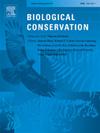Vertebrate scavenger assemblages and their functioning differ between artificial and natural wetlands: Implications for ecosystem management
IF 4.9
1区 环境科学与生态学
Q1 BIODIVERSITY CONSERVATION
引用次数: 0
Abstract
Natural wetlands perform essential ecological functions, but their area has dramatically decreased. Partly to counteract this loss, artificial wetlands have been created. While studies comparing animal communities between artificial and natural wetlands abound, research on their comparative ecological functions is scarce. In particular, vertebrate scavengers in aquatic ecosystems have been little studied despite their critical role in nutrient cycling. This study compared vertebrate scavenger assemblages and their consumption patterns in natural and artificial wetlands in Doñana, Spain, to evaluate the effects of wetland management (natural vs. artificial hydrology) across different seasons. We placed 120 carcasses (carp and chicken) in natural and artificial wetlands. We recorded 22 vertebrate scavenger species efficiently consuming 100 % of carrion in an average of less than two days, highlighting their role in nutrient recycling. Carrion of aquatic-origin was consumed faster and by a greater variety of species than that of terrestrial-origin, facilitating the transport of essential nutrients from water to land. Artificial wetlands exhibited higher efficiency in carrion removal (twice as fast as natural wetlands). However, they hosted less diverse assemblages, dominated by opportunistic and non-native species. This suggests that artificial wetlands are not replacing natural wetlands in terms of biodiversity, despite sustaining water levels and functions. Importantly, ‘kidnapping’ water for irrigation reduces the ability of natural wetlands to maintain ecological functions provided by scavengers. Urgent regulation of water abstraction from aquifers, especially for crop irrigation, is necessary to maintain minimum groundwater levels, preserving the functionality and ecological processes of this critical wetland complex.

求助全文
约1分钟内获得全文
求助全文
来源期刊

Biological Conservation
环境科学-环境科学
CiteScore
10.20
自引率
3.40%
发文量
295
审稿时长
61 days
期刊介绍:
Biological Conservation is an international leading journal in the discipline of conservation biology. The journal publishes articles spanning a diverse range of fields that contribute to the biological, sociological, and economic dimensions of conservation and natural resource management. The primary aim of Biological Conservation is the publication of high-quality papers that advance the science and practice of conservation, or which demonstrate the application of conservation principles for natural resource management and policy. Therefore it will be of interest to a broad international readership.
 求助内容:
求助内容: 应助结果提醒方式:
应助结果提醒方式:


